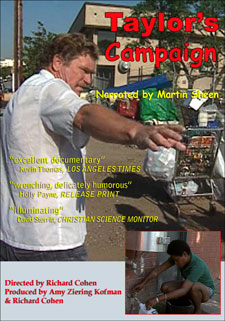
Taylor's Campaign 1998
Distributed by Richard Cohen Films, PO Box 1012, Venice CA 90291; 310-395-3549
Produced by Raindog Films in association with Film Arts Foundation
Directed by Richard Cohen
VHS, color, 74 min.
Adult
Sociology, Urban Studies, Social Work, Anthropology
Date Entered: 11/09/2018
Reviewed by Susan Martin, University of Connecticut LibrariesRichard Cohen's documentary, Taylor's Campaign provides a candid, brutally honest inside look at the tragedy of being homeless in America.
Set in Santa Monica, California in 1994, the documentary follows Ron Taylor, a former homeless truck driver as he runs for city council as an advocate for the homeless. Santa Monica, a wealthy sea-side resort town, had recently seen an increase in both homeless persons and tourists. Deciding the latter was more important, the city passed anti-camping and anti-feeding ordinances designed to drive out the homeless; these ordinances were later repealed when they proved to be unconstitutional.
Cohen presents many different aspects of homelessness. We get to know a small community of homeless people living in Santa Monica's Lincoln and Memorial Parks. Through this community we see the interactions between homeless persons, business owners, social agents (the police), tourists, and housed Santa Monica residents. Throughout the film, Cohen cleverly juxtaposes the interaction between the various players, and the effect is startling. In one scene we see a local charity group run by nurses providing free food to the homeless in Memorial Park as a well dressed and well fed couple, bicycle riding past the food lines, comments that the food lines are an eyesore.
The film is a type of "cinema verité," as Cohen does not direct or interfere with his subjects; nor does Cohen offer any solutions to the problems raised by the film. The homeless are open and candid with their comments; the camera seems to lend credibility to their testimony, as well as effect the behavior of authority figures, such as the Santa Monica police.
The color, sound, and editing are well done. An interesting technical aspect is a "home video" feel to the film, which re-enforces the point that these issues are found in anyone's city or town. Martin Sheen, an anti-poverty activist, provides the small amount of narration that exists in the film.
This film is recommended, and is suitable for both graduate and undergraduate audiences. It would be applicable to students in anthropology, sociology, social work, public policy studies, and urban studies, as it deals with the issues of poverty, unemployment, social services, public policies, hope vs hopelessness, human compassion, or lack thereof, and human dignity.